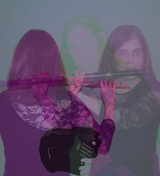In the early days of delta blues, the flute was not found in blues bands for several reasons.
The 8-key wooden flute, most commonly played until after the mid-1850’s, is generally not suited to playing the blues. While fully chromatic, these flutes are more comfortable to play in sharp keys, and do not lend themselves to intricate flat-note chromatic sequences.
Boehm flutes, developed towards the end of the 19th century probably weren’t very available, certainly not second-hand, and would conceivably have been more difficult or expensive to obtain for early blues players.
The flute is also not a particularly loud instrument. In a session full of saxophones, trumpets, fiddles and guitars, flautists would struggle to be heard without amplification, which hadn’t been developed yet.
Alberto Socarras, a Cuban immigrant, appears to be the first flautist to emerge in jazz (and Cuban music) in the late 1920‘s. Just a few years later, Wayman Carver, a black American born in 1905, became the first well-known jazz specialist. Wayman Carver grew up in Virginia, in a family of musicians and his first flute was found by his father in the trash at the naval yards where he worked. Unlike the experience of the poor rural Delta blues musicians, Carver grew up in an urban area, with more job opportunities and more opportunities for advancement. His talent was recognized, and he was given a scholarship to Haven Music Conservatory. He then went on to graduate from Clark University (one of the first private black universities in the United States), attended Juilliard in New York, and taught at Clark. Nevertheless, the Grove Music Online comments:
“Carver’s flute solos on Devil’s Holiday, Sweet Sue, just you (sic), and I got rhythm demonstrate that he was a fine executant, but also that the instrument does not lend itself to rhythmic swing.”
Other well-known or accomplished blues / jazz flute players include: Lateef Yusuf, Herbie Mann, James Moody, Donald Byrd and Bobbie Humphrey (one of the few women, and NOT mentioned in Grove Online, listen from 2:00 below). None of them played the 8-keyed, 19th century wooden flute.
Sources include:
www.flutehistory.com/Playing/Jazz.php3
www.flutehistory.com/Timelines/index.php3
www.allaboutjazz.com/php/musician.php?id=5584
www.oxfordmusiconline.comwww.wikipedia.com
The 8-key wooden flute, most commonly played until after the mid-1850’s, is generally not suited to playing the blues. While fully chromatic, these flutes are more comfortable to play in sharp keys, and do not lend themselves to intricate flat-note chromatic sequences.
Boehm flutes, developed towards the end of the 19th century probably weren’t very available, certainly not second-hand, and would conceivably have been more difficult or expensive to obtain for early blues players.
The flute is also not a particularly loud instrument. In a session full of saxophones, trumpets, fiddles and guitars, flautists would struggle to be heard without amplification, which hadn’t been developed yet.
Alberto Socarras, a Cuban immigrant, appears to be the first flautist to emerge in jazz (and Cuban music) in the late 1920‘s. Just a few years later, Wayman Carver, a black American born in 1905, became the first well-known jazz specialist. Wayman Carver grew up in Virginia, in a family of musicians and his first flute was found by his father in the trash at the naval yards where he worked. Unlike the experience of the poor rural Delta blues musicians, Carver grew up in an urban area, with more job opportunities and more opportunities for advancement. His talent was recognized, and he was given a scholarship to Haven Music Conservatory. He then went on to graduate from Clark University (one of the first private black universities in the United States), attended Juilliard in New York, and taught at Clark. Nevertheless, the Grove Music Online comments:
“Carver’s flute solos on Devil’s Holiday, Sweet Sue, just you (sic), and I got rhythm demonstrate that he was a fine executant, but also that the instrument does not lend itself to rhythmic swing.”
Other well-known or accomplished blues / jazz flute players include: Lateef Yusuf, Herbie Mann, James Moody, Donald Byrd and Bobbie Humphrey (one of the few women, and NOT mentioned in Grove Online, listen from 2:00 below). None of them played the 8-keyed, 19th century wooden flute.
Sources include:
www.flutehistory.com/Playing/Jazz.php3
www.flutehistory.com/Timelines/index.php3
www.allaboutjazz.com/php/musician.php?id=5584
www.oxfordmusiconline.comwww.wikipedia.com




 RSS Feed
RSS Feed